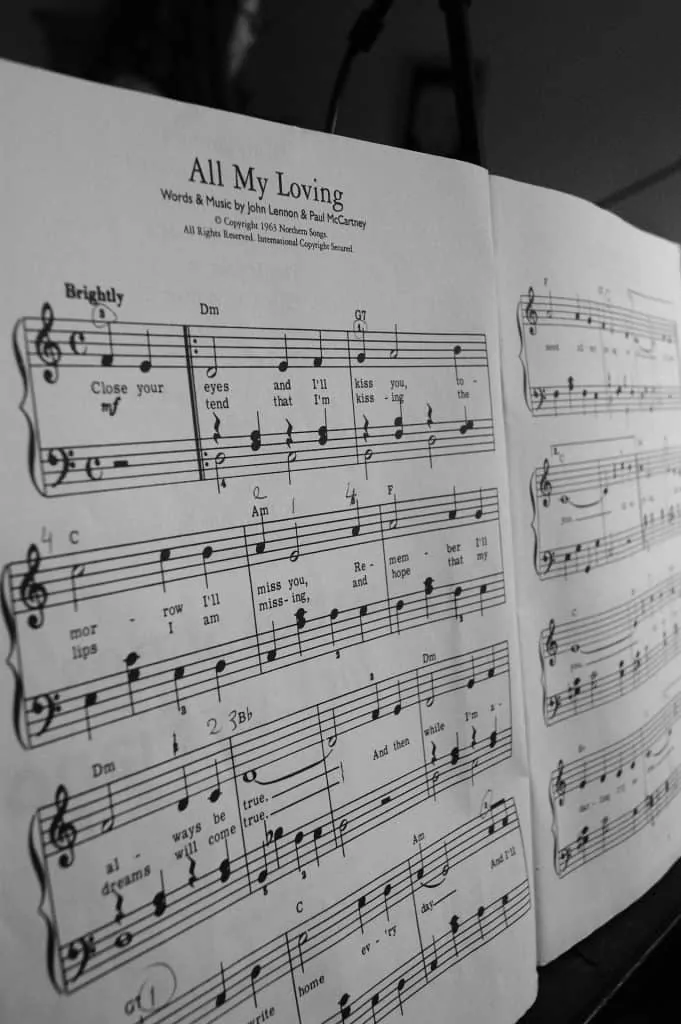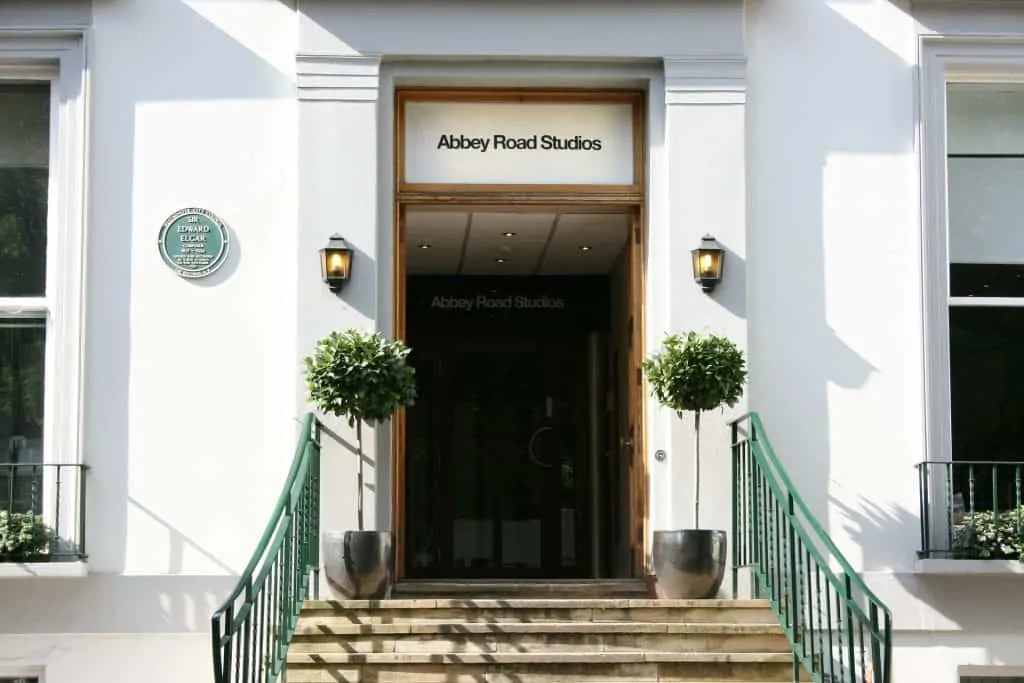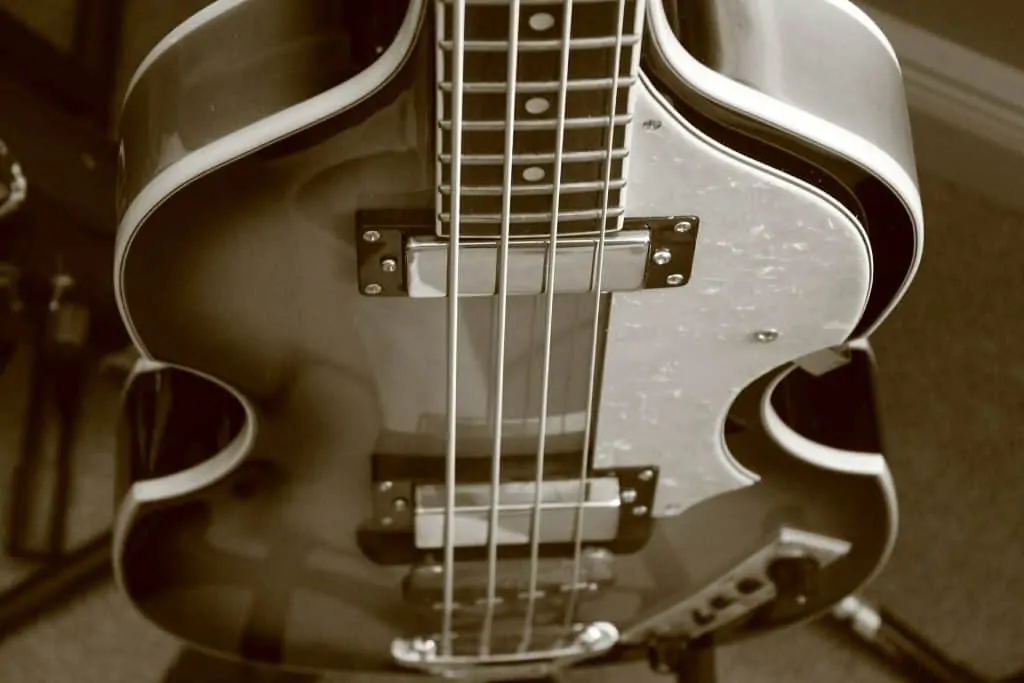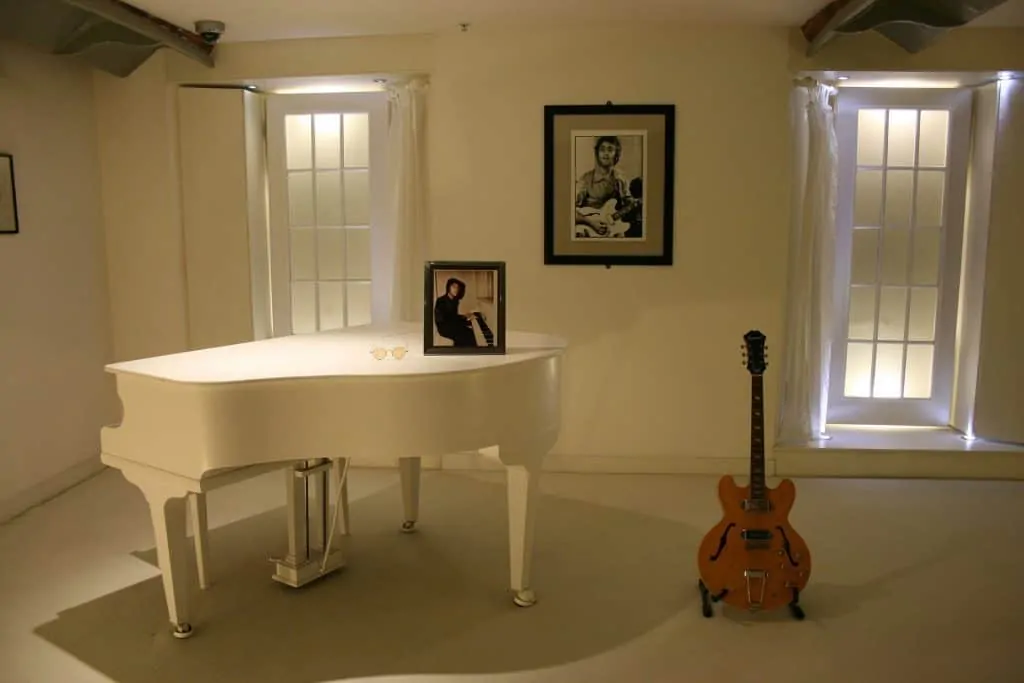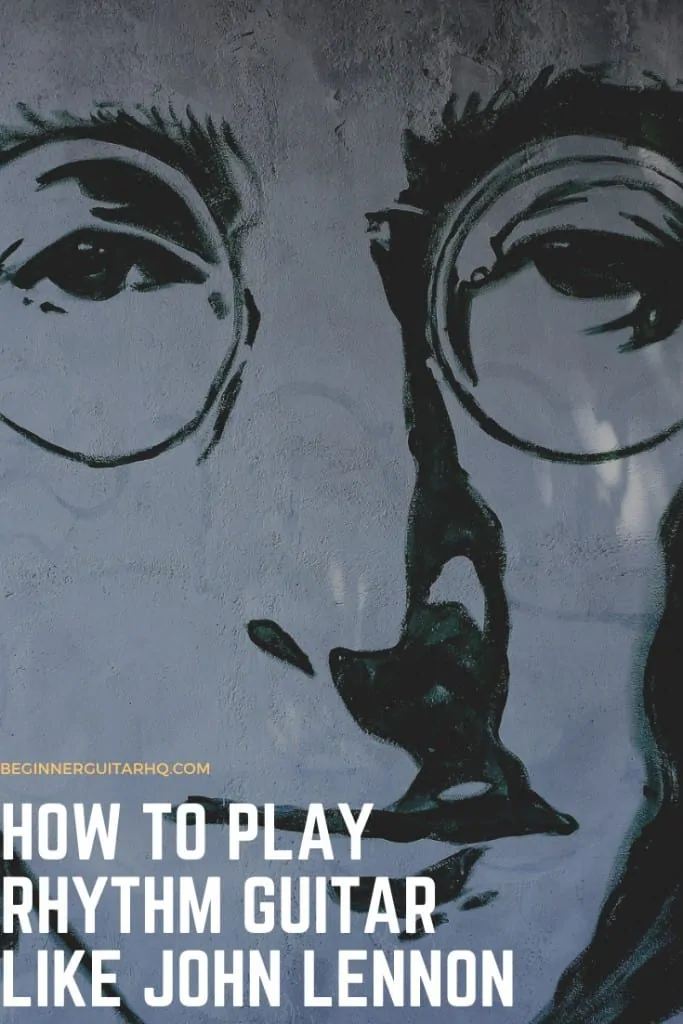Despite a legendary career with the Beatles and as a solo artist, John Lennon remains underrated for his guitar playing skills. Over the course of his lifetime, Lennon established himself as one of the greatest rhythm guitar players in the history of the instrument. Even today, his body of work remains as energetic and dynamic as ever.
If you want to improve your rhythm guitar playing skills, examining Lennon’s style is a great place to start. Between his early rock and roll playing and his later experimentation with different genres, there’s plenty of techniques that you can adapt to your own playing style.
In this guide, we’ll discuss some of the key concepts you’ll find in Lennon’s rhythm playing. Afterwards, we’ll examine some of the former Beatle’s best rhythm guitar parts in specific songs and run down the gear that he used to form his style.
Contents
Key Concepts
Emotion
Even though he became one of the greatest guitar players ever, John Lennon never took a formal lesson! Rather than dazzle audiences with his technical skill, Lennon preferred to communicate through raw, unbridled emotion in his playing.
Lennon’s reliance on emotion and feel undoubtedly had something to do with his lack of technical knowledge. Because he approached learning the instrument by picking up new songs, Lennon never learned how to copy chords by sightreading the way guitarists who play jazz guitar, for example, did. Instead, the Beatle nailed the feel and vibe of each song that he approached.
In a British rock and roll scene dominated by self-taught players, Lennon never needed to distinguish himself on technical skill — indeed, his rhythm playing might have suffered if he had focused on technique more. As a rhythm guitar player, feel and time management are far more important than nailing every note of each chord.
The music scene today is completely different from when Lennon broke onto the stage with the Beatles. However, emotion remains just as important in rhythm guitar playing today as it was in the early 1960s. If you want to improve your rhythm guitar, injecting some emotion into your playing is one of the best ways to do it.
Great Rhythm Songs
While Lennon played rhythm guitar on a host of iconic tracks throughout his life, a couple in particular stand out for their quality and creativity. These songs are by no means the only great John Lennon rhythm parts — but they are some of the coolest! If you want to pick up more from Lennon’s rhythm style, it’s a good idea to listen through the Beatles catalogue and some of John’s solo albums as well.
With that disclaimer out of the way, here are some of John Lennon’s greatest rhythm parts along with the full songs. These parts shine, often becoming the defining feature of the track they appear on; they’re also chock-full of valuable techniques for any player who wants to take after the Liverpool native’s approach to rhythm guitar. Let’s take a closer look and check each song out!
The complex chord changes on “All My Loving” make it a difficult song to play on rhythm guitar!
“All My Loving”
An early Beatle standout from the group’s second LP, “All My Loving” was one of the first tunes where John managed to take over a song completely with his rhythm guitar. Though Paul McCartney’s melody is infectious (and his bass playing is nimble), it’s Lennon’s triplet-centric rhythm strumming that takes over the pulse of the song.
This tune is an outstanding example of a simple modification that can make a huge difference. Strumming in triplets doesn’t require a change to any of the chords or even a modification to the “on” and “off” beats of the song. However, dividing each beat into three subdivisions completely alters the feel of the track. And while it may be conceptually simple, it’s still deceptively difficult! You’ll likely need to practice for some time before you can nail the tune at speed like John did.
Take a listen to “All My Loving” in the video above. As you hear the song, take note of how steady the rhythm guitar remains throughout the song. Whether he’s on the verse or chorus, Lennon never wavers. As with other patterns, the little details here also contribute greatly to the sound.
If you listen closely, you’ll hear that Lennon accents the first beat of every triplet, which is each numbered beat of the measure (the one, two, three, and four). Triplets can often be distracting to listeners because there’s so much strumming going on. Lennon avoids that with these clever accents — even though he’s strumming like a madman, the accents on each beat keep his audience locked into the groove throughout.
You should also pay attention to the contrast in rhythm between the chorus and verses. The tempo and pulse of the song don’t change, which ordinarily might allow the chorus and verse to bleed together into one big mess. Lennon, however, keeps that from happening by deftly switching to a different strumming pattern during the chorus. This pattern is significantly less busy, and accents the off beats of the bar at times. Both of these tweaks create a decidedly more of a “swinging” and less of a “driving” feel than you find in the verses.
Emulating the triplet strums in your own songs can be difficult because Lennon made them so famous. At this point, “All My Loving” is such a well-recognized tune that listeners may instantly connect any triplet strumming with the Beatles rather than your band! However, you can still use triplets for emphasis at certain points in your song or to create a sense of excitement during a bridge. There are few better ways to drive a rhythm forwards with some flair. Just remember to accent the on beats!
Abbey Road Studios, where the Beatles recorded nearly all of their albums.
“Norwegian Wood (This Bird Has Flown)”
Just three short years after releasing “All My Loving,” the Beatles had grown into a monumental creative force. Rubber Soul, their sixth studio album, marked a serious turning point for the band towards adult topics and sophisticated lyrics. Oftentimes, they reflected that shift through their songwriting and rhythm playing. “Norwegian Wood (This Bird Has Flown)” is one of those times.
The vast majority of early Beatles songs begin with the vocals, or with just a bar or two of introduction before the vocals enter. While the intro to “Norwegian Wood” might seem short by today’s standards, it was a longer buildup than you’d find throughout the rest of the band’s catalogue to that point. That extra time created a void, which Lennon filled by merging rhythm and lead guitar into an outstanding single part.
Listen to “Norwegian Wood” using the video below. Chances are, you’ll immediately notice how the rhythm guitar introduces the primary melody of the song, which the vocals later follow. This sort of chord-based sound wasn’t uncommon for the Beatles, but it was unusual to see them play the main vocal melody on guitar before actually singing it!
Besides the history and context of the track in the Beatles’ body of work, “Norwegian Wood” is simply an excellent example of working a melodic hook into a rhythm guitar part. This is a tricky skill to pull off, because when done wrong it can butcher the timing and sway of a good melody. If you can pull it off, though, the results are spectacular.
Lennon’s rhythm guitar here introduces the audience to the primary melody in the beginning of the track, without any introduction or dead space. He continues to play the same pattern throughout the bridge, always mirroring the melody. This creates a lovely doubling effect that strengthens both Lennon’s voice and his guitar. When they play together, they push the song forwards in a way that seems both forceful and soft.
“Girl”
Another one of Lennon’s greatest compositions off of the outstanding Rubber Soul, “Girl” is an angst-ridden ballad that thrives on space and timing rather than rhythm and drive. It makes a lot of sense, then, that Lennon opted for a much more laid-back approach to the rhythm guitar on this song.
He eschews the wild triplet strumming found in “All My Loving” for a few lilting, sparse chords played on an acoustic guitar. This part offers a great example of setting the mood of a song with the rhythm guitar. Where early Beatles tunes were upbeat, boppy, and filled with energy, “Girl” signified a major step forward into more complex topics (along with other songs on the album, like the aforementioned “Norwegian Wood (This Bird Has Flown)”).
Take a listen to the tune below and focus on the acoustic guitar rhythm. As you hear the song, notice how the guitar sounds so offbeat and deliberately messy — almost as if Lennon was just strumming absentmindedly without a clear rhythm.
In most scenarios, the lack of direction would create an ineffectual and pointless song. Here, however, it marries perfectly with Lennon’s lyrics, which detail the passion and anxiety the narrator feels towards the titular girl. It’s an exceptionally raw track, and rather than polish off the edges the rhythm part leans into the vibe. That gamble certainly pays off when you listen to the song.
While “Yer Blues” left the early image of the Beatles behind, it did incorporate some heavy rock and roll rhythms reminiscent of the group’s early days.
“Yer Blues”
This song moves much further into Lennon’s career with the Beatles. After the massive productions that were Revolver and Sgt. Pepper’s Lonely Hearts Club Band, the Beatles were feeling stressed creatively and wanted to get away from some of the grand orchestration they had favored in their last album. The result was The Beatles, often referred to as “The White Album” for the color of its cover.
“Yer Blues” is one of John Lennon’s most memorable compositions on the double LP, in part because of its cutting genre parody and in part because of its morose sort of catchiness. It also features another stunner of a rhythm part!
Listen to “Yer Blues” through the video below this paragraph. As this tune was an intentional parody of the incredibly sad blues songs of the day, it features over-the-top lyrics and instrumentation. Listen in particular for the jagged, ripping guitar licks that Lennon plays after the end of each vocal line.
More than “bookending” each lyric, these riffs contribute a great deal to the sound and vibe of the song. Their stabby shape and blown-out sound contribute to the song’s over-the-top blues atmosphere. Beyond that, though, they’re just plain cool! These lines are some of the hardest, raunchiest Delta blues guitar lines that anyone created in the ‘60s.
If you’re looking to take something away from this rhythm part, you should note that “rhythm” guitar doesn’t always have to mean “playing block chords.” In fact, Lennon drops out entirely during the vocals, leaving only the bass and drums to carry the song forward. It’s a smart strategy that’s intended to shift the focus of the song to the words he’s singing.
However, pulling it off requires you to create some strong licks that can serve as “shorthand” for all of the rhythm changes of your song. The 12-bar blues format makes this much easier — Lennon only needs to hit a couple of notes to convey the V, IV, and I chords within the same lick.
In fact, the minor pentatonic scale and blues scale work so well over all three of these chords that it’s not even necessary to outline each different chord individually. If you want to go for this sparse approach to rhythm playing, make sure that you start out with a harmonically simple pattern.
In addition to Lennon’s rhythm guitar, “Come Together” centers around a heavy bass riff from Paul McCartney.
“Come Together”
As the opening track to Abbey Road and one of Lennon’s most famous compositions, “Come Together” has few equals in terms of success and classic status. The song itself sounds very simple, both in harmonic and rhythmic terms. However, the chugging, pulsing rhythm part is a classic in its own right — and one of the finest examples of John Lennon’s rhythmic intuition throughout his career.
Cue up “Come Together” from the video below, and the first thing that you’ll notice is the alternating on-and-off rhythm. The guitar clearly accents every other stroke, which creates a “walking” feel.
Likewise, the first stroke of each pair comes across as a choppy staccato note, while Lennon allows the second strum to linger for a bit longer before cutting it off to move into the next pair. It’s particularly noticeable in his rendition of the song live from New York City. This strengthens the loping vibe created by the alternating emphasis and injects a bit of personality into what would otherwise be a relatively robotic rhythm part.
“Come Together” also offers valuable lessons about chord selection. Right after Lennon exclaims the title of the track, he begins a downward run of four chords: a descending Bm, A, and G, followed by a return to the A chord.
Not only is the Bm chord unexpected since the rest of the song follows a rough blues pattern in the key of Dm, but the upward shift at the end of the sequence is a major curveball. It delays the smooth resolution down to the I chord (Dm) until after Lennon finishes the lyric (with an unaccompanied “over you!”) and moves into the next verse.
As with many of his other rhythm parts, the strumming here serves to accentuate the words and move the attention to the central theme of the song rather than steal the limelight on its own. U These tracks accomplish a lot more than just keeping a steady beat! But while the underlying ethos may be difficult to implement at first, if you apply it to your own songs you can greatly improve the strength and cohesion of your tunes.
“Cold Turkey”
This single, originally released in 1969, was one of Lennon’s first major solo hits. Even though it captures Lennon just as he was breaking up with the Beatles, it still contains many of the hallmarks of his unique solo style. Listen to the audio of the track below to hear how it sounds.
Like many of Lennon’s greatest solo hits, “Cold Turkey” is built around a stark, jagged riff that he repeats throughout the song. In fact, this riff is often the only guitar part that appears — Lennon declines to play any sort of rhythm throughout the vast majority of the song!
Though it may seem like a stark approach, the riff-based part found in this cut exemplifies some of the greatest features of Lennon’s songwriting. Rather than clutter or overcomplicate a rhythm part, the Beatle knew when to keep things simple and straight to the point. Taking this approach and applying it to your own songs can help you weed out any parts that don’t serve the purpose of the song but hang around to fill space.
However, if you’re going to cut out most of the rhythm it’s also important that what you leave sounds good! “Cold Turkey” succeeds because the central lick is so powerful and raw. Before yyou try to build a song around a riff or lick like this, make sure that it’s sturdy enough to carry the weight of vocals and rhythm without extra support.
“Hold On”
Compared to all of the rough, blues-based rock and roll guitar playing that Lennon was so fond of, “Hold On” displays a completely different side to his playing. The rhythm guitar part here, soaked under waves of tremolo, feels so delicate that it might crack! But even though it’s so distinct from the rest of Lennon’s work, “Hold On” still reveals a few amazing concepts you can implement in your own playing.
First off, Lennon’s rhythm part here relies on a mix of single notes and chords intertwined with each other. While these notes don’t mirror the vocal melody exactly, they do bounce off of Lennon’s spoken lines and replicate some parts of the lyrics. It’s an outstanding example of a rhythm that’s integrated completely with the song.
Beyond the interlocking structure of the rhythm, the heavy tremolo effect is another highlight. This can be difficult to pull off on many songs — particularly because tremolo can destroy your tempo and feel if you don’t use it right — but here it creates a lilting, swaying effect that underscores the calm and relaxed feel of the tune.
Adding heavy effects to your rhythm playing doesn’t always work out, but when done well it can be a very distinctive feature. It’s a great idea for any song if you want to create something a listener can easily remember.
John Lennon’s Essential Gear
Any player with a career as long and historic as John Lennon’s will use lots of different gear. And as guitars, amps, and effects improve in quality over time, it’s easier than ever to achieve plenty of different sounds with less and less equipment. However, different models still offer very different strengths; certain pieces of equipment often lend themselves naturally towards playing in a certain style.
If you want to truly emulate the feel of John Lennon’s rhythm guitar playing, you might want to check out some of the essential gear that the man favored. While you can obviously still apply his techniques and study his songs without these items, you may find that they’re better suited to accomodate all of the nuances and tricks that made Lennon’s rhythm style so iconic.
John Lennon’s Rickenbacker 325, like the model in this photo, and Vox amplifier powered the early Beatles sound.
Guitars
Rickenbacker 325
Lennon’s 1958 Rickenbacker 325 stuck with the musician from when he purchased it in 1960 all the way until the end of his life 20 years later. It’s the guitar that he played throughout the Beatles’ early residencies in the German city of Hamburg and on most of their pre-1965 albums and tours. All in all, it’s hard to overstate the importance of this model on the guitar world — it’s quite possibly one of the most famous (and certainly one of the most expensive!) instruments in history.
But while many people assume that Lennon first purchased the model 325 because he wanted any American guitar that he could get his hands on, the truth runs much deeper. The 325 is a ¾-scale guitar, which makes it perfect for the chugging rock and roll rhythms that the Beatles loved to employ.
Rather than a standard 24.75” or 25.5” scale, the Rickenbacker 325’s scale is just over 20” long — roughly equivalent to placing a capo on the third fret of a standard guitar. The shorter distances between frets helped Lennon pound out barre chords using the famous Chuck Berry-style patterns which alternated between the fifth and sixth note of the chord.
It’s no overstatement to say that the 325’s size was the defining factor in many early Beatles rhythms. Think about John’s complex triplet pattern on “All My Loving,” which we spotlighted in the “songs” section above. With less distance to go between the different chords in that sequence, Lennon was able to stay on beat and maintain a rock-solid foundation which became one of the defining characteristics of the tune.
The Rickenbacker also offered a bright, punchy tone that offered a lot more treble than was common on rhythm guitar. In comparison to relaxed, warm rhythm patterns on some other tracks, Lennon’s 325 brought a frenetic, cutting energy to each song. It proved the perfect way to slice through crowded mixes on studio tracks and in a live setting, and helped establish rhythm guitar as an essential role in a band rather than an auxiliary piece.
Along with his all-white piano, Lennon’s Epiphone Casino has become one of the musician’s most recognizable instruments.
Epiphone Casino
Later in his time with the Beatles, Lennon shifted to an Epiphone Casino for his rhythm and lead work. While it offered a different tonal palette from the Rickenbacker, Lennon created some of his best rhythm parts on the Epiphone — thanks, in large part, to the guitar’s unique sound and style.
In contrast with the chambered Rickenbacker, the Casino’s hollow body gave it a warm, woody tone with plenty of acoustic resonance. Rather than elbowing its way to the front of a mix, the Casino created a lush, smooth sound that pinned down plenty of memorable tracks. It’s the guitar Lennon used on the legendary “rooftop concert” from Apple Records.
However, that’s not to imply that the Casino couldn’t produce some incredible distorted tones! All you need to do is look at songs like “Revolution” or “Yer Blues” to hear the cutting, ripping sound of an overdriven Casino. As far as hollow-body guitars go, it’s hard to find a more versatile model than this one. It’s one of the best rock guitars around.
Les Paul Jr.
Along with the Rickenbacker 325 and Epiphone Casino, Lennon used instruments like the Fender Stratocaster throughout his time with the Beatles. It was the mahogany red Les Paul Jr. that he picked up after leaving the group, however, which became one of his most enduring instruments.
In comparison with the chambered Rickenbacker and hollow Casino, the Les Paul Jr. is a fully solid model — it’s heavy and offers plenty of power and sustain. It’s the modifications that Lennon added, however, that truly make this instrument special.
The Les Paul Jr. featured a P-90 pickup in the bridge, just like the Casino that Lennon loved so much. However, this guitar originally came without any pickup installed in the neck position — a design feature that lowered the price of the instrument but also reduced its versatility. Lennon had luthier Ron DeMarino add a Charlie Christian pickup into the neck position; the addition gave the guitar a smooth, clean neck tone in addition to the hard-edged bridge P-90.
This is the model that Lennon used to craft many of his solo hits. If you’re looking for a versatile instrument with its own distinct character, a Les Paul Jr. with a Charlie Christian pickup like Lennon’s is a good model to check out.
Even today, Lennon’s legacy lives on through his discography and influence over other musicians.
Summary
John Lennon’s rhythm guitar style paved the way for dozens of other iconic players. In no small way, Lennon was the engine that fueled the rise of the guitar as a rhythm instrument. And though his style contains many different facets and approaches depending on each song, a couple tenets remain the same throughout the former Beatle’s discography.
First and foremost, Lennon kept things simple. One of his greatest strengths was knowing when to accentuate a rhythm part and when to let it stand on its own weight. Developing this sense on your own takes time, but it can transform your rhythmic and compositional skills alike.
Beyond his simplicity, Lennon’s emotion was the other constant animating feature of his playing. The man attacked the instrument with a ferocity and drive that few other players in the history of the guitar have managed to copy since. As you strive to emulate the master’s rhythm guitar, keep this emotion in mind. It’s often better to play raw and eel the spirit than to drill the life out of a certain part and lose your feel for a certain tune in the process.
Whether you’re studying Lennon’s rhythm for your own playing or if you just love the Beatles and want to learn more about their “forgotten guitar player” (as Lennon once remarked), this guide contains most of what you need to know. Keep playing and work on the techniques mentioned here (particularly with a metronome) to take full advantage of Lennon’s prodigious skills!

